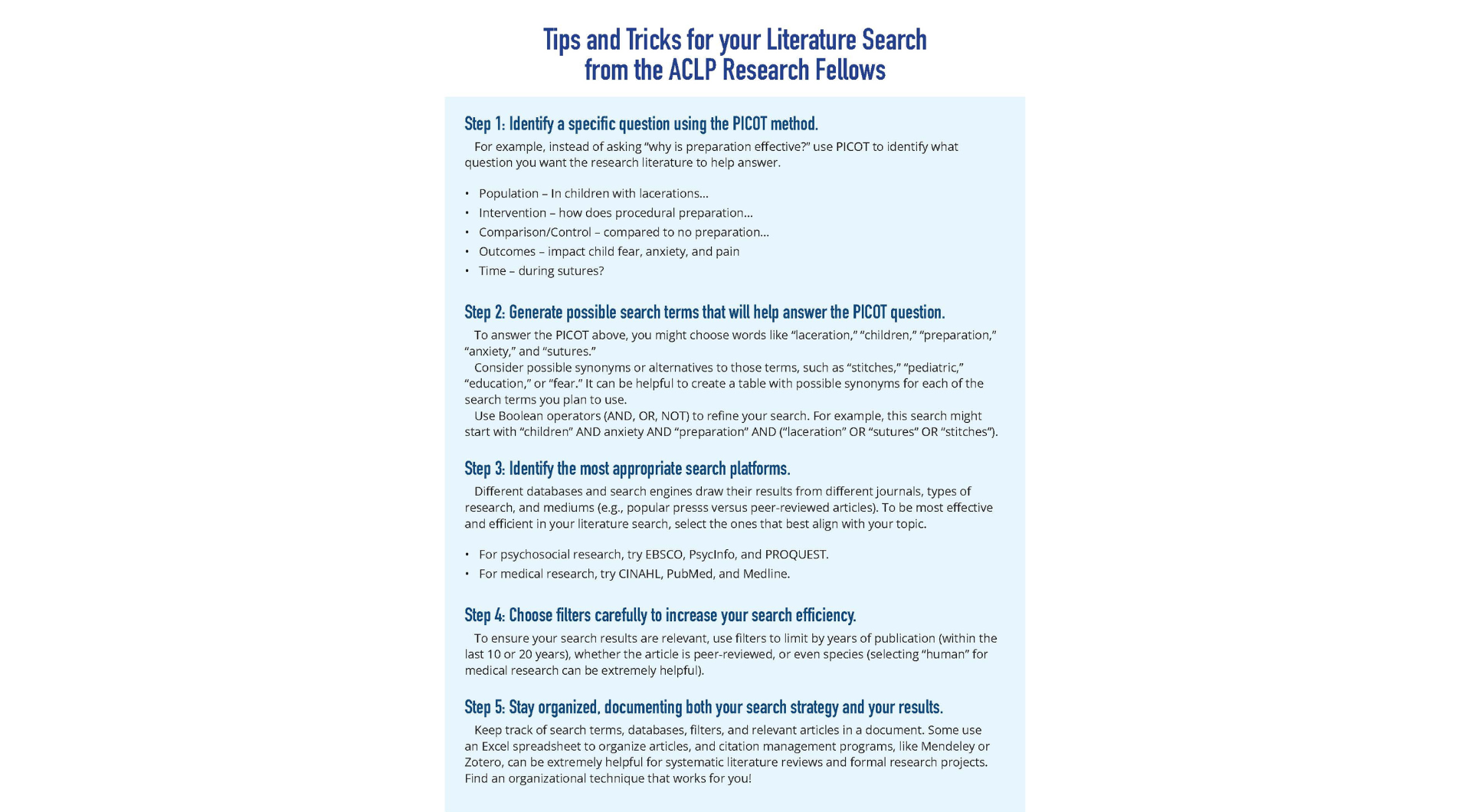.png?sfvrsn=8c9a944d_0)
By Jennifer Fieten, MA, CCLS
As a child life specialist working in both clinical and academic roles, I commonly find myself gathering research in order to inform my practice and to integrate into policies, procedures, and various proposals. While some may, understandably, view this as a challenging task, I have often found this to be both exciting and energizing. A research search provides the opportunity to review what is new in the field, to acquire new and useful information, and to then share what I have learned with others. This article will describe the steps of conducting a research search and demonstrate how I use a review of literature to support patients in my clinical role.
Topic Identification
To begin exploration of existing research, it is important to clearly identify the topic for study or the question that one hopes to answer. As a child life specialist working in a healthcare facility, which focuses primarily on rehabilitation, the specific nuances of some medical conditions warrant deeper understanding to develop a plan of care and be prepared to answer questions in a developmentally appropriate manner. After having multiple patients with post trauma amnesia (PTA), I found it extremely important to learn more about this particular condition and to learn about the behavioral manifestations commonly seen in individuals with PTA, as well as the stages that one frequently progresses through in transitioning out of this state. As such, I sought to learn more by exploring articles related to this topic, using “pediatric patients with post trauma amnesia” as my search subject. By using this topic, I then would also have the option of searching for research using just “post trauma amnesia” or “pediatric trauma” as search phrases to further explore.
Research Filters
Once my topic was identified, I logged into my medical library account at work and conducted a preliminary search using my initial search phrase. This search yielded 22 articles for review. I then chose to filter my results by exploring only those resources that were from peer reviewed journals and that were in article format. Incorporating these filters then narrowed the available articles to 18 for review. Some researchers may encourage focusing on articles less than ten years old. For the purposes of my exploration, I chose to then refine my article review to articles that were less than five years old to ensure that the research and data contained was the most relevant and up to date. Following this refinement, the available articles again narrowed to include 7 scholarly journal articles. If my search had encountered challenges, such as difficulty finding articles on my specific topic, I could have requested assistance from the hospital librarian, which would be an option in university settings as well.
A Topical Review of the Literature
A review of the literature means a review of the current thinking on the topic represented in the scholarly journal articles obtained. A preliminary review of the articles found that a majority of the research focused on diagnosis of traumatic brain injury (TBI), the symptoms associated with TBI, and the potential outcomes of TBI, with minimal specific focus on post trauma amnesia. This led me to recognize the need for additional research on this topic as well as a need to adjust search terms and phrases in the hopes of obtaining additional scholarly articles.
Application to Practice
The research I did gather contributed to an advanced understanding of traumatic brain injury, increased knowledge of the physical healing process, and treatment options for managing symptoms, all of which were helpful in developing a child life plan of care for patients with whom I worked. Understanding this condition assisted me in providing emotional support (stressing the importance of reiteration, understanding emotional lability), tailoring interventions (challenges to emotional regulation), and advocating on the behalf of my patients (acknowledging the potential for heightened fight or flight responses), all of which built on my existing knowledge of trauma-informed care. Recognition of the need for further research on post trauma amnesia specifically contributed to my interest in pursuing research projects to examine this issue more closely.
Conclusion
The ability to seek and gather research to inform practice and to integrate into policies, procedures, and various proposals is integral to the work of the child life professional. Whether it be to learn more about a particular diagnosis, a new medical test or procedure, a research based intervention strategy, or to identify new intervention tools, we utilize research in a variety of ways. As demonstrated in my recent information gathering experience, a preliminary search may not yield the expected results. Rather than viewing this as a failure, it is viewed as an opportunity to re-evaluate the search terms to see if an adjustment is needed or an invitation to contribute to an area of research that is lacking. This is one of the exciting aspects of research gathering, identifying what is needed to obtain the most useful, evidence-based information.

